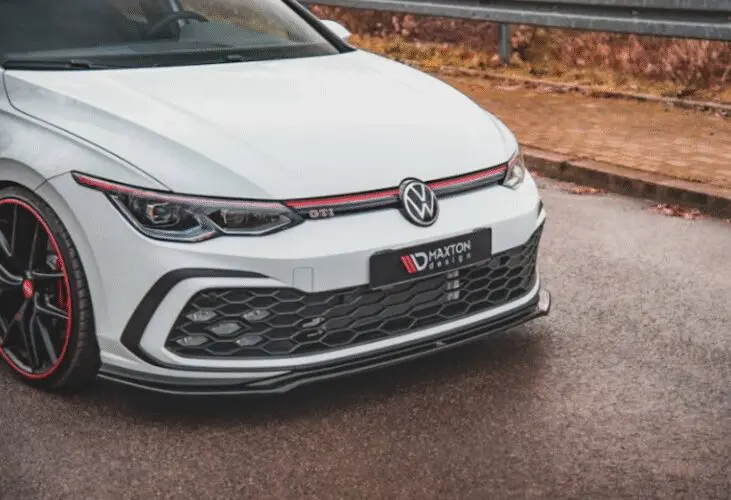3 Powerful Aftermarket Exterior Upgrades To Transform Your VW Golf
Long considered the benchmark for the hatch car class, the VW Golf is now in its eighth generation, and has regularly topped sales charts as one of the UK’s favourite models. The car has defined the hatch and hot hatch sectors ever since the first Golf MK1 hit the streets in 1974, and the souped-up GTi with all of its 110hp, just a couple of years later. A lot has changed since then, but the Golf was and remains the car to beat for all-round versatility without having to remortgage your house.
Well-balanced for the school run or testing your driving chops on the track, the car balances comfort with performance in a compact and conservatively styled package. It might not have the bling factor of aspiring competitors, but by blending form and function, it gets most things right.

For anyone who missed out on the factory R and R-Line, or Black and Performance packs, fear not. The aftermarket has comparable, OE-fit VW Golf styling parts, sold either as separate parts or packaged kits. These let you get closer to the design language in the GTi and R models in the lower trims at half the price.
Dress Your Golf in an Aftermarket Body Kit
To suit the power output in performance models (260-ish hp/370Nm of torque in the GTi, and 328hp/420Nm in the R), both cars distinctly differ from your regular 1.5TSi or the different 2.0 TDI diesels. More aggrieve front bumpers with larger air scoops get more into the engine, and subtle rear roof spoilers, rear diffusers and side skirts in the Oettinger styling packs mean this is a car meant to be pushed. The aim is to get more traction on the wheels, keep the car stable at speed, and cut drag with reduced body roll and crisper braking, also thrown into the mix.
Aftermarket kits can save you considerable cash without forsaking quality, performance or a clean fit.
This is true for all Golf models. Besides value, also consider an aftermarket body kit if the following tick your needs:
- Improved aero performance and handling: Front splitters, side skirts, rear diffusers and spoilers aren’t just for show. Each manages airflow hitting the car, reducing drag and boosting stability. Splitters channel air over, under and around the car to cut lift and create downforce. Side skirts stop air pooling underneath, while diffusers and spoilers stabilise the rear axle. Together, they give any Golf sharper cornering, better steering feel and quicker throttle and braking response – turning a daily hatch into something you’ll actually want to drive.
- Protecting the engine and factory bodywork: Reinforced, injection moulded ABS plastics resistant to heat extremes, impact, and UV radiation reduce the likelihood of surface scratches, deeper dents and paint deterioration, keeping adjacent parts and the factory bodywork intact. With more space between the car and the road, aftermarket styling parts for your Golf also prevent rust buildup from excessive moisture and road debris.
- Reduced weight: Factory bumpers, hoods, panels and aero additions can get heavy due to the choice of heavier polypropylene (PP). ABS trims the Golf’s dry weight. For pure racing applications, also look into significantly lighter body parts in carbon fibre. These additionally benefit from higher tensile and compressive strength, outpacing the stock aluminium and steel panels.
- Getting the look you’re after: While the recommendations are to use complete body kits for a seamless and streamlined car aesthetic, Golf owners can mix and match parts according to taste. This also relates to colours and finishes to accentuate different car parts.
Choosing the Right Materials
Materials determine strength, weight and impact and heat resistance, among other parameters. They also impact the end price. Choose ABS for affordability, decent weight, high strength and rigidity (ABS parts resist cracking) and simple maintenance with periodic cleaning.
Polypropylene parts are heavier for the same strength (need to be optioned thicker), but benefit from higher flexibility without deforming or bending under loads, such as high-speed cornering or abrupt braking. PP components also need more prep work in matching bodywork with the factory colour. Like ABS, they’re affordable (and slightly cheaper), do better against road debris and chemicals (oil, grease, brake fluid, etc) as well as high heat (excessive braking, suspension heat in uneven roads), making them an approachable choice for light track work.
If you’re fitting VW Golf styling parts to a new, eighth-gen (or 8.5) R and GTi, and price isn’t an issue, go with parts and accessories in pre-preg carbon fibre. This is a high-performance material with exceptional strength, very low weight and an appealing, uniform, interwoven finish primed for racing. For the price, you’re getting a material that copes with exceptional stresses to increase downforce in the wheels and tyres for unmatched performance benefits (cornering stability, faster acceleration), without succumbing to warping, cracks and deformation.
Just ensure to get a professional fit. This rules out misalignment, damage to the body kit and adjoining parts due to increased vibrations or performance penalties from increased drag.
Pair Body Kit with Matching Alloys 
Performance Golf R models ride on 18″ and 19″ inch forged wheels in a black power-coated or polished chrome finish. These are factory options from VW’s in-house tuning arm, setting you back a couple of thousand pounds when fitted on anything below the GTi variants. The multi-spoked forged design promises considerably lower weight than standard cast wheels in the same dimensions, considerably more strength in harder driving, and spoked profiles that direct air onto the brakes for more efficient brake cooling.
VW owners can spend a fraction of that cost for equally capable flow-formed and forged wheels from aftermarket suppliers. Besides production methods for increased strength and matching performance characteristics, and sizing wheels in the right width and height, consider specifics like offset that determine how the Golf sits relative to the surface, and bolt patterns to match the stock wheel hubs.
Negative offset (relative to the factory settings) directly impacts steering feel and overall stability, and gets a more aggressive look with the wheels pushed further out. This also creates the space for bigger brake kits, tuned suspension setups (coilovers, lower springs) and more traction with semi-slicks for the street or dedicated racing slicks for the track.
Bolt on a Performance Exhaust
With factory options ranging from simple axle-back exhausts to spruce up the sound in regular Golfs, to exorbitantly-priced high-end full turbo-back systems for special editions of the Golf R, there’s a huge variety of aftermarket exhausts to choose from. Builds, materials, designs, and aesthetics differ for the different Golf models and badges.
If you’re looking to blend performance and style, a stainless steel OPF-back exhaust for the GTI and R in wider (3.15″) tubing, a choice of tip finishes (burnt or brushed titanium, polished steel or carbon fiber) and integrated street-legal resonators for controlled noise levels, punches far above the reasonable asking price, both in terms of power benefits and overall styling.
Regardless of which aftermarket system or configuration you choose, a well-built exhaust provides snappier throttle response with more efficient airflow and reduced restrictions, a deeper and raspier sound, higher durability with heat and fatigue-resistant alloys, and reduced weight, despite the wider piping. The inclusion of head-turning tips, cleaner designs and seamless welds (for reduced vibrations) rounds out a component that sets the groundwork for all subsequent tuning jobs with new engine parts, ensuring all that newfound power doesn’t get wasted.
Read more on
MyCarHeaven are on Instagram. Go check us out and do follow us.
Go visit the MyCarHeaven Instagram page. We post regular quality content, predominantly focused on classic cars, supercars, hypercars and car shows. We also feature all our competitions here, where you will have the chance IF YOU FOLLOW US and you follow the competition entry criteria, you could be in with a chance of winning tickets to the best UK car shows, and other automotive stuff.
Go to the MyCarHeaven Instagram account here. Advertisement
Advertisement Advertisement
Advertisement Advertisement
Advertisement Advertisement
Advertisement




